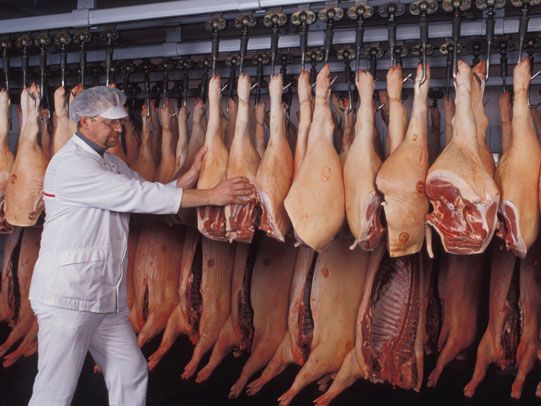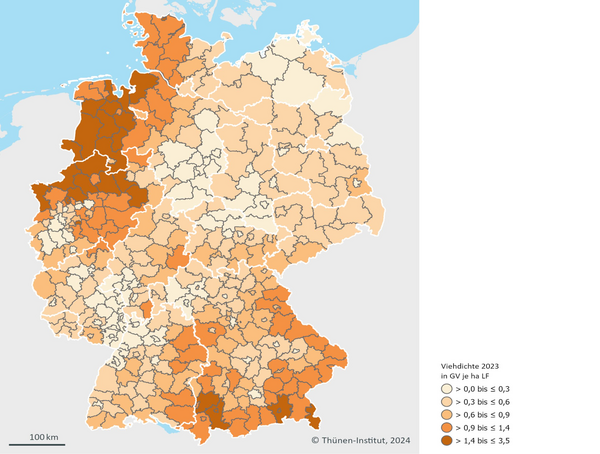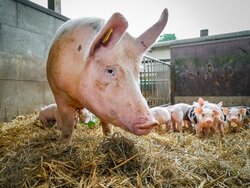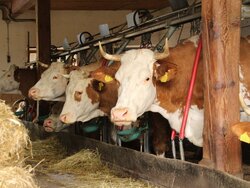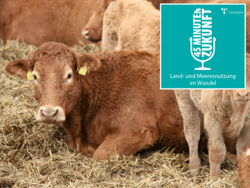Dossier
Livestock farming and meat production in Germany
Claus Deblitz, Katrin Agethen, Josef Efken, Hauke Tergast, Raphaela Ellßel, Heiko Hansen, Zazie von Davier, Petra Thobe, Craig Chibanda, Sebastian Koch | 10.11.2025
How many tons of meat are produced in Germany? How much of it is exported? We answer these and other questions about animal husbandry and meat production in Germany with a synopsis of current data.
Compared to 2010, milk production in Germany increased by around 12 per cent by 2024 to a level of almost 34 million tonnes in the year 2024. However, this increase was largely due to the phasing out of the milk quota in 2015. This makes Germany the largest milk producer in the EU. However, the number of dairy farms has fallen by half since 2010 to 47,700. Due in part to the comparatively high prices for dairy products, domestic demand for dairy products such as cheese and drinking milk fell in 2023 but increased again slightly in 2024. According to AMI (Agrarmarkt Informations-Gesellschaft mbH) figures, per capita consumption recently stood at 24.5 kg of cheese and 46 kg of drinking milk.
According to the new BLZ figures, meat consumption has fallen from just over 7 million tonnes in 2010 to 6.05 million tonnes in 2024. However, compared to the year 2023, in 2024 consumption increased by approximately 121 000 tonnes and 2 percent, respectively. This corresponds to a per capita disappearance of 73 kg and a per capita human consumption of 53 kg. Meat production, on the other hand, has initially increased almost every year since the BSE crisis in 2001 – measured in terms of slaughter volume – and stood at just under 8.8 million tonnes in 2016. Since then, there has been a decline to 7.3 million tonnes in 2024. This represents the first increase since 2016 and corresponds to a plus of 122 000 tonnes compared to the year 2023.
The significant decline in pig herds and pork production is the main driver of the overall decrease of meat production in Germany. The main reasons for this development are changes in consumption habits and the occurrence of African swine fever in 2020, with the associated loss of third-country exports, particularly to China. In addition, there was periodic "pig congestion" in the barns due to the lack of slaughter capacity during the Covid pandemic.
Finally, the stricter regulations and social debate in the areas of animal welfare and environment should also be mentioned, as well as the lack of perspective on the part of the market and politics, like the recent withdrawal of the federal support programme for higher animal welfare standards in pig production. All in all, these developments are leading to great uncertainty among producers, the closure of farms and a lack of investment in sustainable housing and husbandry concepts.
The meat balance is calculated as follows: The quantity of meat produced nationally + meat imports - meat exports equals the calculated domestic meat consumption. Meat consumption includes all uses, including quantities that are not consumed by humans, such as the use of fat and bacon in industry. Conversion factors are then used to calculate the proportion that ultimately "actually" represents human meat consumption.
This calculation was left unchanged for 30 years and was therefore reviewed. The review primarily led to two noticeable adjustments, which have been implemented since 2022:
- A greater proportion of the carcass is for human consumption than in the original calculation. In other words, a larger proportion of meat consumption is human consumption.
- In the original calculation, in relation to the import and export of meat, a) several meat parts were not taken into account at all and b) some meat parts were allocated to offal and by-products, although they are meat parts from cattle or pigs or poultry and are therefore measured on the carcass.
The correction of these gaps and incorrect allocations led to an increase in net exports for Germany, particularly for pork, so that the calculated meat consumption is lower than based on the original calculation method. We have taken these changes into account at the relevant points in the fact sheets.
Nevertheless, Pork is still the most important type of meat in Germany. However, per capita consumption fell from 49 to just under 35 kilograms between 2010 and 2024. In contrast, the slaughter volume has risen steadily over the last 20 years from around 4.1 million tonnes to around 5.6 million tonnes in 2016. Since then, there has been a decline in production to 4.289 million tonnes in 2024 which represents the first increase since long with a plus of 104 000 tonnes and 2.5 percent compared to 2023, respectively. Despite the outbreak of African swine fever in September 2020, Germany remains a net exporter because in the EU the regional concept applies and trade is still permitted.
In contrast, a positive trend in production and consumption can be observed for poultry meat. Both production and consumption have increased. The slaughter volume of poultry has risen from 1.3 million tonnes in 2010 to 1.528 million tonnes in 2024, overtaking beef production in terms of importance but merely unchanged compared to 2023. In 2024, Germans consumed 1.721 million tonnes of poultry meat. After a decline in 2022, this represents a slight increase again and corresponds to a per capita consumption of 20.6 kg per person. However, production and consumption did not reach the record levels of the coronavirus year 2020. Despite the positive development of demand, Germany remains a net importer of poultry meat with a trade balance of -192 000 tonnes.
The volume of beef slaughtered fell from just over 1.2 million tonnes in 2010 to 1.05 million tonnes in 2024, a minor increase compared with 2023. Consumption in 2024 amounted to 970,000 tonnes, which corresponds to a per capita consumption of 11.6 kg per person and is also slightly higher than in the previous year. The overall trend of beef production points downwards due to the reduction in dairy cow herds.
The production and consumption of sheep and goat meat is significantly less important in Germany compared to other types of meat. According to official statistics, 29,590 tonnes of sheep and goat meat were produced in 2024 compared to 56,648 tonnes consumed. Per capita consumption is only 0.68 kg per year, a continuing downward trend.
Overall livestock numbers are declining. It is not possible to state the exact number of animals as of the reporting date, as the animal populations are not surveyed for all animal species in every year and on the same reporting date.
Unsurprisingly, poultry has the highest share in terms of numbers. In 2020, a total of 170 million animals were kept in Germany; of these, 107 million were fattening birds including turkeys, ducks and geese. The number of laying hens has risen constantly and stood at 45 million animals in 2024.
Pig farming is also of high importance in Germany in terms of numbers. In the May 2025 census, the number of pigs was 20.91 million animals, continuing a clear downward trend. Of these pigs, almost two-thirds are fattening and young pigs.
The cattle herd has also continued to decline to just over 10 million head in May 2025, with 3.6 million dairy cows also at the lowest level in the last 20 years.
Sheep farming plays only a minor role, with just over 1.5 million animals kept in November 2024.
More than half of all cattle farms in Germany have fewer than 50 animals. In contrast, 52 percent of all cattle in Germany are kept in herds of more than 200 animals. This corresponds to around 11 percent of farms. With regard to the farm structure in cattle farming, it must be taken into account that all cattle categories (dairy cows, suckler-cows, beef finishing cattle) are included here.
Farm structures for pigs are similar to those for cattle: Almost half of all pigs kept in Germany are in herds with more than 2,000 animals. As with cattle, the farm structure of pig farming is not the same in all production directions. For example, farms in pig fattening are comparatively larger than those in sow farming.
The trend toward large flocks is even more pronounced in poultry: on the one hand, most farms in Germany keep no more than 100 young broilers. On the other hand, 79 percent of young broilers are kept in flocks with more than 50,000 birds. In the case of laying hens, 4 percent of farms have more than 100,000 laying hens and represent just under 35 percent of flocks.
This map is based on data from Destatis and our own calculations for 2023.
Measured in terms of livestock units (LU) per hectare of utilized agricultural area (UAA), the center of the finishing industry (pig and poultry farming) is located in northwestern Germany and in the foothills of the Alps.
The regional centers for cattle farming are mainly in Lower Saxony, North Rhine-Westphalia, Schleswig-Holstein and Bavaria. Dairy cows and suckler cows are mainly located in counties with a high proportion of grassland.
Download Service
The "Livestock Fact Sheets" (Steckbriefe zur Tierhaltung), which have been published for several years and are updated annually, are intended to provide a brief overview of meat production, consumption and foreign trade. They also provide information on the development of livestock, farm structures and the spatial distribution of production in Germany.
The fact sheets deliberately do not address the diverse and ongoing discussions on the topic of animal husbandry in Germany (and worldwide), but provide a basic contribution to be able to conduct precisely this social and political discussion on the status quo and the future of animal husbandry in Germany on a solid information basis.
The fact sheets are published in German only.
- Steckbriefe zur Tierhaltung in Deutschland: Ein Überblick
- Steckbriefe zur Tierhaltung in Deutschland: Schweine
- Steckbriefe zur Tierhaltung in Deutschland: Milchkühe
- Steckbriefe zur Tierhaltung in Deutschland: Mastrinder
- Steckbriefe zur Tierhaltung in Deutschland: Legehennen
- Steckbriefe zur Tierhaltung in Deutschland: Mastgeflügel
- Steckbriefe zur Tierhaltung in Deutschland: Aquakultur

